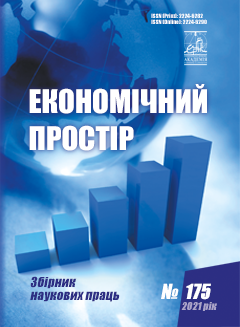КЛАСТЕРНІ МОДЕЛІ РОЗВИТКУ СКАНДИНАВСЬКИХ КРАЇН
Анотація
Конкурентоспроможні кластерні економічні моделі розвитку разом із циклічною економікою є перспективними моделями регіонального розвитку в умовах глобалізації. Скандинавські країни відрізняються високими показниками інноваційного та економічного розвитку, високим рівнем життя, соціального захисту та забезпечення населення. У статті досліджено досвід Скандинавського кластера у розвитку біоекономіки та циркулярної економіки, який може використовуватися країнами з транзитивною економікою та країнами, що розвиваються, для підвищення їхньої конкурентоспроможності. Зазначено, що кластерна модель розвитку, заснована на циркулярній економіці, дає змогу підвищити інноваційність економіки, добробут населення, а також зменшити кількість відходів, розвивати альтернативні джерела енергії та «зелений» туризм.
Посилання
Адаманова З.О. Інноваційні кластери в національних економічних системах (НЕС): світовий досвід і можливості його адаптації в умовах України. Формування ринкових відносин в Україні. 2012. № 5/1. С. 162–163.
Портер М. Конкуренция. Москва : Вильямс, 2006. 608 с.
Рибак Ю.В. Теоретичні засади дослідження розвитку та функціонування кластерів в умовах глобальної конкурентної боротьби. Формування ринкових відносин в Україні. 2012. № 2(129). С. 94–102.
European Commission (2017). Review of the 2012 European bioeconomy strategy. Brussels: European Commission. URL: https://ec.europa.eu/research/bioeconomy/pdf/review_of_2012_eu_bes.pdf.
Європейська кластерна обсерваторія. URL: https://ec.europa.eu.
Кластер (економіка). URL: http://uk.wikipedia.org/wiki.
Іванченко Г.В. Розробка кластерної моделі розвитку регіону: методологічний підхід. Ефективна економіка. 2013. № 5. URL: http://nbuv.gov.ua/UJRN/efek_2013_5_51.
GrunfelderJ., NorlénG., RandallL., GassenN. S. State of the Nordic region 2020. Nordic Council of Ministers Nordens Hus Ved Stranden 18 DK-1061 Copenhagen. 2021. 172 p. URL: https://pub.norden.org/nord2020-001/nord2020-001.pdf.
Ринейська Л.С. Кластери у сучасній глобальній економіці. Ефективна економіка. 2016. № 5. URL: http://nbuv.gov.ua/UJRN/efek_2016_5_33.
AnnalaK., Teräs J. Nordic working group for green growth – innovation and entrepreneurship 2013-2016 Synthesis report. Nordregio Report Stockholm: Nordregio, 2017.
Stukalo N., Simakhova A. Social Dimensions of Green Economy. Filosofija. Sociologija. 2019. T. 30. № 2. Р. 91–99. DOI: https://doi.org/10.6001/fil-soc.v30i2.4015.
Sigfusson T. The new fish wave. Maine, Leete’s Island Books, 2019.
Adamanova Z.O. (2012).Innovatsiyni klastery v natsionalʹnykh ekonomichnykh systemakh (NES): svitovyy dosvid i mozhlyvosti yoho adaptatsiyi v umovakh Ukrayiny[Innovation clusters in national economic systems (NES): world experience and possibilities of its adaptation in the conditions of Ukraine]. FormuvannyarynkovykhvidnosynvUkrayini. 5/1, pp. 162–163.
Porter M. (2006) Konkurentsyya [Competition] M .: Williams Publishing House, 608 p.
Rybak Yu.V. (2012)Teoretychni zasady doslidzhennya rozvytku ta funktsionuvannya klasteriv v umovakh hlobalʹnoyi konkurentnoyi borotʹby [Theoretical bases of research of development and functioning of clusters in the conditions of global competition]FormuvannyarynkovykhvidnosynvUkrayini.2 (129), pp. 94–102.
European Commission (2017). Review of the 2012 European bioeconomy strategy. Brussels: European Commission. Retrieved from:https://ec.europa.eu/research/bioeconomy/pdf/review_of_2012_eu_bes.pdf
EuropeanClusterObservatory.Retrieved from: https://ec.europa.eu
Cluster (economics) Retrieved from: http://uk.wikipedia.org/wiki
IvanchenkoG.V. (2013) Rozrobkaklasternoyimodelirozvytkurehionu: metodolohichnyypidkhid[Development of a cluster model of regional development: a methodological approach]Efficient economy. 5. Retrieved from: http://nbuv.gov.ua/UJRN/efek_2013_5_51.
Grunfelder J., Norlén G., Randall L., Gassen N. S. (2021) State of the Nordic region 2020. Nordic Council of Ministers Nordens Hus Ved Stranden 18 DK-1061 Copenhagen. 172 p. Retrieved from: https://pub.norden.org/nord2020-001/nord2020-001.pdf
Ryneiska L.S. (2016) Klastery u suchasniy hlobalʹniy[Clusters in the modern global]Efficient economy. 5Retrieved from:http://nbuv.gov.ua/UJRN/efek_2016_5_33.
AnnalaK., Teräs J. (2017) Nordic working group for green growth – innovation and entrepreneurship 2013-2016 Synthesis report. Nordregio Report Stockholm: Nordregio.
Stukalo N., Simakhova A. (2019) Social Dimensions of Green Economy, Filosofija. Sociologija. T. 30. Nr. 2, p. 91–99.DOI:https://doi.org/10.6001/fil-soc.v30i2.4015.
Sigfusson T. (2019) The new fish wave. Maine, Leete’s Island Books.



